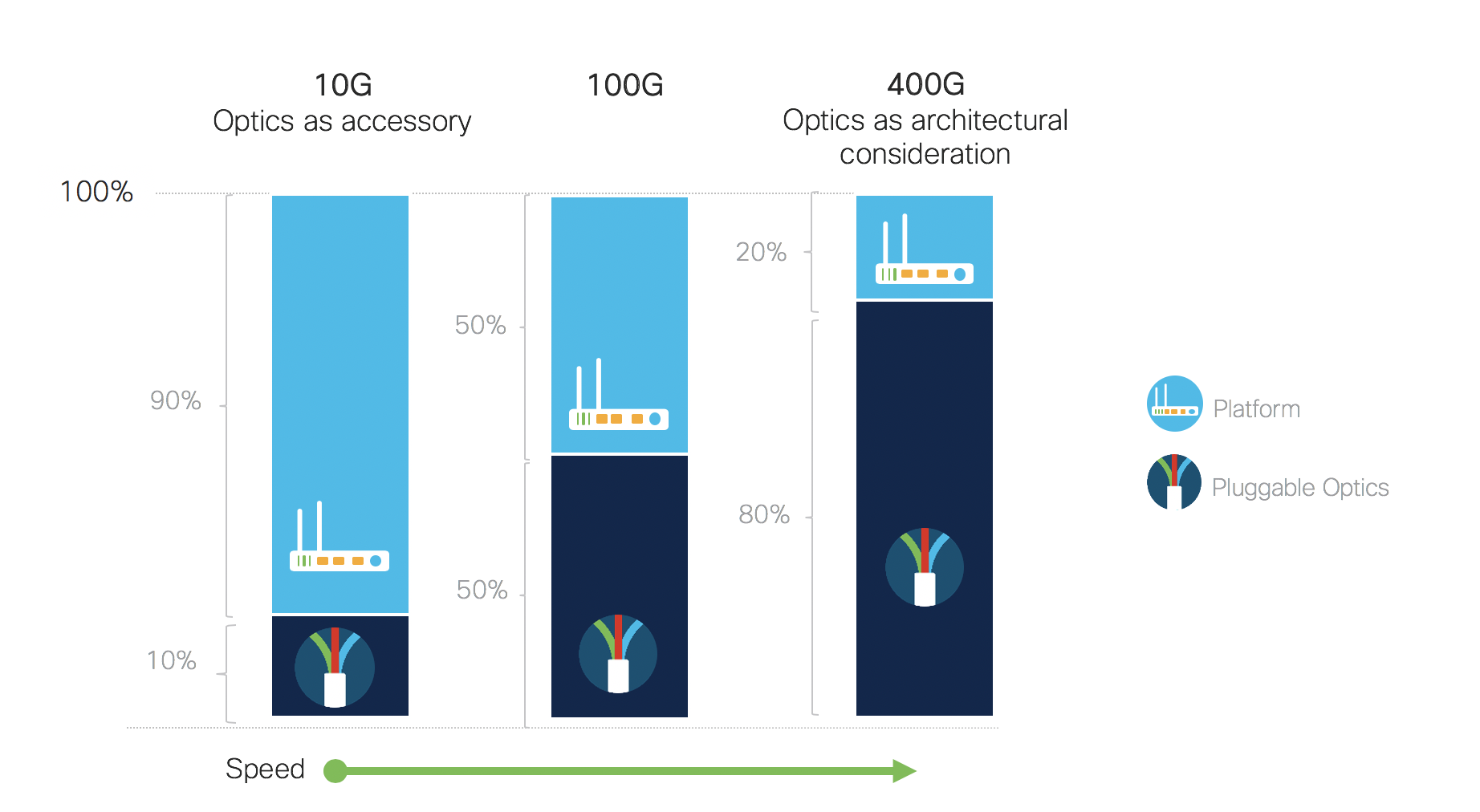Subscribe to the Cisco Optics Blog
We recently introduced the QSFP28 100G FR pluggable transceiver. This may be one product, but it’s the beginning of a bigger industry dynamic that will change 100G pluggable optics over the next several years. To understand why we will need a change, let’s first review a bit of the past.
Back when 10G SFP+ pluggable optical modules were the state of the art, choices were few and simple. Furthermore, the modules themselves were straightforward in that their sole function was to convert electrical signals into optical signals, and vice versa.
In the years that followed, network bandwidth demands increased which meant that the data rate of optical links also had to increase. And it not only got faster – it accelerated. Standards bodies such as the IEEE and SFF had to consider methods that went beyond faster lasers and photo-receivers. Techniques such as WDM (wavelength division multiplexing), parallel fiber, CTLE (continuous time linear equalization), and FEC (forward error correction) were built into standards.
Such complexity has consequences not only in the cost of the pluggable optical modules themselves but also in fiber infrastructure design, which has implications in both hardware cost and operational cost. Complexity also increases the risk of failed interoperability between the pluggable optic and the switch or router, and between pluggable optics from different vendors.
In the future, network bandwidth demands will eventually require 100G optics to mature to the point where it’s just like today’s 10G SFP+ in terms of cost and volume manufacturability. We can’t get there with the complexity of today’s 100G. Therefore, a fundamental change is needed.

This is where single-lambda 100G comes in. Its optical specifications were first standardized by the 100G Lambda MSA (multisource agreement). The IEEE is also standardizing similar specifications such as 100GBASE-FR1. Led by Cisco Optics experts, this specification quickly gained broad industry support due to its vision to create cost-effective solutions for high-density multi-terabit switching, routing, and transport networks. The goal was to allow for future 100G and 400G pluggable optics that can be scaled to high-volume manufacturing, and therefore achieve low cost.
The basis of the single-lambda approach is the use of PAM4 (four-level pulse amplitude modulation). Prior to this, nearly all 100G optical specifications incorporated NRZ (non-return to zero), which is a two-level binary modulation format. PAM4, however, contains twice the amount of data without requiring significant increase in the speed of the optical components. Therefore, the same fundamental optical technology that can carry only 50G with NRZ can be used for 100G PAM4.
The key is that the full 100G data stream is transmitted by a single laser. That means no WDM or parallel fiber. And with advances in SERDES and form factors, we will be able to take FEC out of the module as well. These are critical to getting to the next generation of 100G optics.
Look for more posts in the upcoming weeks on single-lambda 100G. Better yet, subscribe to the Cisco Optics blog!

While speeding up baud rate & larger constellations is one strategy, beyond 100 Gbit/s is there some value to moving to parallel “OFDM” style maximally packed subcarriers running at lower baud rates and smaller (still single laser), such as Infinera XR optics?
Hi Thomas, OFDM was under consideration by the industry at one time, but it didn’t gain traction. PAM4 was viewed as more feasible in terms of simplicity and power. Trade offs between complexity and other considerations, like cost and power consumption of the pluggable module, are always factors when new standards are developed. This is to ensure that there will be enough players in the market that can compete using the selected technology. Thanks for your comment!
This solution is a exceptional tool for distances, I have been using similiar technology since 2009 and seemingly bullet proof light.
Hi Allen, yes, PAM4 is certainly not a new modulation format. Glad to hear you’ve had success with it for so long. We’re excited to see it in pluggable optics now. Thanks for your comment!